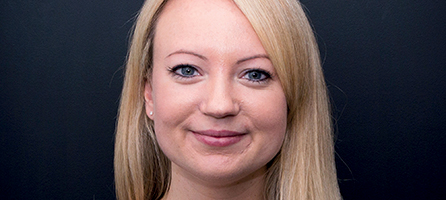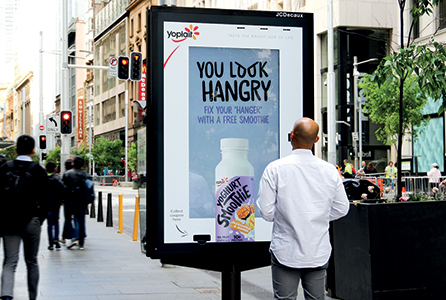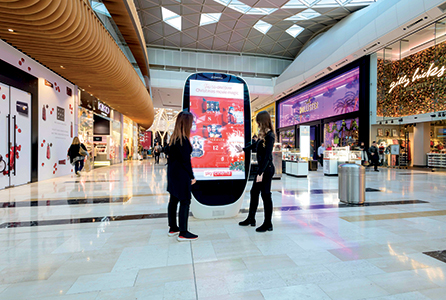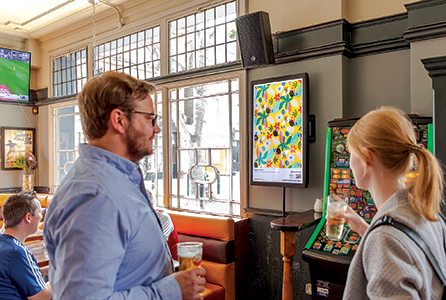
The Department of Culture and Tourism – Abu Dhabi and Ocean Outdoor set a new Guinness World Record for the ‘Largest Augmented Reality Screen’
Connection Perfection
Digital signage already offers certain advantages to marketeers, with the ability to bring more life to advertising campaigns and update the message on the sign at the push of a button. However, not ones to rest on their laurels, developers in this area of the market are continuing to push the boundaries.
Much of the focus in recent years has been on interaction, with marketeers and their clients keen to attract as much consumer attention as possible. One sure-fire way of doing this is interacting with the customer through advertising, with digital signage playing a key role in this.
From facial recognition and augmented reality (AR), through to setting new Guinness World Records and mass karaoke sessions, SignLink takes a look at some of the most innovative, interactive digital signage projects in recent times.
Integral component
Ocean Outdoor is one of the leading names in digital signage technology within the UK market, working with a wide range of brands on campaigns. Catherine Morgan, director of Ocean Labs at Ocean Outdoor, says consumers now expect brands to be more interactive with their advertising and marketeers must react in order to retain their attention.

Catherine Morgan, director of Ocean Labs at Ocean Outdoor, says consumers expect brands to be more interactive with advertising
“Large-format interactive digital screens are integral to the pop-up experience-led culture where consumers want to be taken on a journey with that brand,” Morgan says, adding: “We use premium broadcast-led content to connect hard to reach audiences with personal, immersive outdoor brand experiences – which they say they like and trust.”

Large-format interactive digital screens are integral to the pop-up experience-led culture where consumers want to be taken on a journey with that brand”
Morgan goes on to cite Ocean Outdoor’s latest YouGov consumer survey, which shows that 49% of 18 to 24-year-olds would be interested in seeing more live content on digital out-of-home advertising screens. In addition, one in four say they are more likely to engage with adverts that appear alongside live broadcast content such as entertainment, news and sport.
“Interaction means deeper engagement and cut through with those hard to reach audiences,” Morgan says, adding: “Ocean’s screens are configured to deliver live streamed, dynamic content alongside relevant advertising, which research shows drives up effectiveness five times versus pure ad play alone.”
Looking at some of the recent work by Ocean Oudoor, Morgan cites a number of projects that showcase its ability to help brands interact with consumers. A new campaign that launched in January with energy company EON aims to highlight the dangers of air pollution in the UK and show how it is working to improve air quality and provide customers with 100% renewable energy.
Participants stand on the floor vinyl activation zone in front of the screen, and when their face is detected, an AR experience is triggered. Live localised air pollution data is displayed on the screen along with the street name, and AR allows the participants to see the pollution particles visualised in the mirror stream.
O Factoid: In November 2019, the Department of Culture and Tourism – Abu Dhabi and Ocean Outdoor set a new Guinness World Record for the ‘Largest Augmented Reality Screen’. The screen, installed at Piccadilly Circus in London, measured in at 548.47sq m. O
Facial detection uses the mouth position to augment animation of the pollution as it appears to be inhaled and exhaled. A message then appears warning that pollution is often worse closer to the ground, impacting children the most.
Ocean Outdoor was also involved in a campaign with Coca-Cola and the Landsec Piccadilly Lights in London, where popular Christmas carols were projected on the giant landmark for an hour, inviting festive visitors and shoppers to join a flash mob choir in singing the songs. The event was streamed on the big screen allowing attendees to see themselves on the Piccadilly Lights.
Open a dialogue
Elsewhere and another major player in this market is JCDecaux, which runs a wide range of campaigns with leading brands around the world. Albert Asséraf, executive vice president, strategy and user innovation of JCDecaux, and David McEvoy, marketing director of JCDecaux UK, say marketing communication has entered a period when the consumer experience, their participation and involvement is more important, in a world that has become more virtual.

JCDecaux and Yoplait rolled out an interactive digital signage campaign in Sydney, Australia where if people walking past a screen smiled, they were given a coupon for a free smoothie
Asséraf and McEvoy expand: “Interactive digital signage is a major advantage for outdoor whether this is in terms of pure out-of-home (OOH) or combined digital out-of-home and mobile. Brands can now open up a dialogue with customers through real live experiences that can be amplified via social sharing.
“This technology can provide a new channel of communication for brands, with considerable potential as the technology is reliable, efficient and improving. Creative agencies and brands have the capacity to create campaigns that are informative, entertaining, amusing or even generous.
“And as this interactivity is generally at the consumer’s initiative it increases the campaign’s efficiency, reinforcing the impact of our media.”
JCDecaux works with marketeers in the UK and around the world, and Asséraf and McEvoy pick out some recent examples of interactivity in motion. In Sydney, Australia for a Yoplait campaign, if people walking past a JCDecaux screen smiled, they were given a coupon for a free smoothie.
At Changi Airport in Singapore, JCDecaux worked with Absolut Vodka on a campaign where passengers were asked to take a selfie with their smartphone then upload it onto the campaign’s mini-site. Faces, created based on hundreds of photos, then appeared on screens inside the airport.
Meanwhile in the UK, customers at Westfield shopping centres in London and Stratford were invited to interact with a JCDecaux touchscreen by ‘opening’ windows on an Advent calendar to discover films shown over Christmas on Sky.

The joint JCDecaux and Sky campaign at Westfield shopping centres in London and Stratford invited consumers to interact with a touchscreen by ‘opening’ windows on an Advent calendar to discover Sky films
In addition, for the new Men in Black film, an experiential stand in Waterloo station invited users to join the London Branch of MIB by creating their unique ‘Branch ID’ video – a bespoke GIF capturing the person putting on the infamous MIB black sunglasses. This GIF was then uploaded to the large digital screen at Waterloo for everyone to see and share. Around 1,400 GIFs were created during the campaign.
Asséraf and McEvoy add: “While sight has been the main sense used for OOH over the years, interactive digital signage can also activate on touch, gestures, voice and, potentially, hearing. Add mobile technology such as NFC, Bluetooth and applications in the wider sense, and the conditions are hugely positive for continuous innovation in OOH experiences.”
Drive conversations
Another company active in this area is Clear Channel, which works with a wide range of brands on interactive and digital campaigns. Among its more recent project was a partnership with Stonegate Pub Company, whereby the OOH media owner introduced around 150 digital screens, as part of the Socialite network, into pubs and bars up and down the UK, including Yates and Walkabout.

Clear Channel recently rolled out 150 screens across pubs and bars owned by the Stonegate Pub Company
Speaking about the benefit of these signs, compared with the more traditional installations, Clear Channel’s joint managing Richard Bon picked out a number of key points. These include the screens bringing maximum value for brands, as well as high dwell times and full motion HD capabilities bringing what he described as “infinite creative opportunities to engage and target customers”.
In addition, venues are able to feature their own content on the screens, tailoring the messaging and graphics to interact with customers in a new and engaging way.
Bon comments: “Pubs and bars are at the heart of our communities and the country’s number one social destination so advertisers can truly benefit from this unique opportunity to reach young and sociable audiences in a relaxed and receptive environment. Socialite ads can help to drive conversations in real time and create that extra incentive to engage with brands, even through mobile devices.”
Clear Channel’s consumer interaction stretches further than just digital, with the company last year working with Brighton and Hove City Council to transform a bus shelter using some waste materials from the nearby beach – with the idea of promoting recycling to the public, while allowing brands to advertise digitally at the location.
The shelter featured a ‘living roof’, made from Sedum plants that were planted in upcycled plastic bottle recovered from the beach by Clear Channel, helping to give them new life and purpose. Hoye’s Home & Garden assisted with the choice of plants, while creative signage expert Russells was responsible for the build of the shelter.
Will Ramage, joint managing director at Clear Channel, says: “We’re pleased to be continuing Clear Channel’s proud tradition of working on projects that go beyond just advertising, help give back to local communities, and benefit the environment.”
The general consensus among these signage specialists is that interaction with the consumer is key if brands are to capture attention in what is an increasingly digital world. By featuring some form of interaction feature within a sign, you immediately make it more interesting to the consumer, which in turn will boost your chances of them taking notices of what the brand or retailer is promoting.
Your text here...